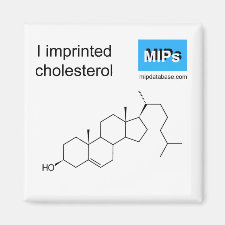
Authors: Wybranska K, Szczubialka K, Nowakowska M
Article Title: Photochemical molecular imprinting of cholesterol.
Publication date: 2008
Journal: Journal of Inclusion Phenomena and Macrocyclic Chemistry
Volume: 61
Issue: (1)
Page numbers: 147-151.
DOI: 10.1007/s10847-007-9407-z
Abstract: Abstract Cinnamoylated photocrosslinkable cyclodextrin derivatives (BCC) were synthesized by the substitution of ?-cyclodextrin (?-CD) with cinnamoyl chloride (CC) and crosslinked with either hexamethylenediisocyanate (HMDI) or toluenediisocyanate (TDI). Cyclodextrin rings were substituted with one or two cinnamoyl moieties, as found from mass spectrometry. The polymeric matrix with cholesterol molecular imprint was obtained on irradiation of molecular assembly formed by the cinnamoyl-functionalized ?-cyclodextrin-cholesterol with light at 275 nm, absorbed exclusively by the cinnamoyl chromophores. Irradiation induced crosslinking due to the photodimerization of the cinnamoyl moieties. To determine the adsorption properties of the produced material imprinting was performed in the presence of tritiated cholesterol and the intensity of ? radiation from the material was measured. The materials obtained by the adsorption of tritiated cholesterol by nonirradiated polymer were used as controls. It was found that the polymer photocrosslinked in the presence of cholesterol have shown a considerable higher adsorption capacity for cholesterol than the control materials. This confirmed successful formation of molecularly imprinted polymer (MIP) by photochemical crosslinking. The selectivity of imprinting was also confirmed using compounds of similar structures, i.e. ergosterol, dehydroergosterol, and Vitamin D
Template and target information: cholesterol
Author keywords: molecular imprinting, cholesterol, photodimerization, Photocrosslinking, cyclodextrin, Chromophore



Join the Society for Molecular Imprinting

New items RSS feed
Sign-up for e-mail updates:
Choose between receiving an occasional newsletter or more frequent e-mail alerts.
Click here to go to the sign-up page.
Is your name elemental or peptidic? Enter your name and find out by clicking either of the buttons below!
Other products you may like:
 MIPdatabase
MIPdatabase









